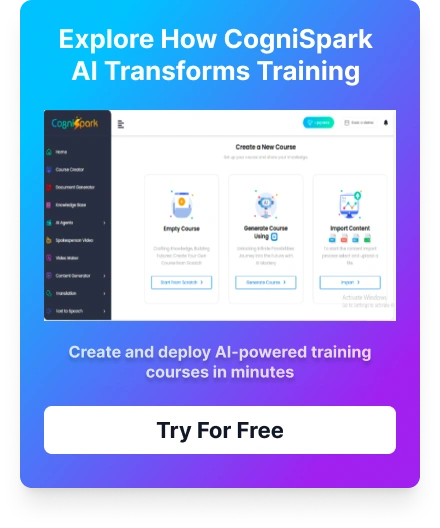In today’s fast-evolving digital learning landscape, AI authoring tools are revolutionizing how instructional content is created, customized, and delivered. From corporate L&D teams to educational institutions, these tools promise speed, efficiency, and innovation. But a pressing question remains—do AI authoring tools ensure instructional design quality?
With the rise of AI powered authoring tools, the instructional design process is experiencing a significant transformation. While these tools can generate content rapidly, the quality of instructional outcomes, learner engagement, and alignment with learning objectives is critical. In this blog, we’ll delve into how AI-driven solutions are impacting instructional design and whether they truly uphold its principles.
What Are AI Authoring Tools and How Do They Work?
AI authoring tools are software applications that use artificial intelligence technologies like Natural Language Processing (NLP), machine learning, and automation to streamline the eLearning content development process. They can automate tasks such as:
- Generating course outlines
- Creating assessments and quizzes
- Providing real-time feedback
- Translating content into multiple languages
- Personalizing learning paths
These tools adapt and learn from user behavior and inputs, improving the content generation process over time. A good AI powered authoring tool doesn’t just create content—it enhances learner engagement through interactivity, adaptive learning, and data-backed insights.
Can AI Authoring Tools Replace Traditional Instructional Designers?
This is one of the most frequently asked questions—and the answer is no. AI tools are powerful, but they’re not a replacement for skilled instructional designers. Instead, they serve as enhancements.
Instructional design involves understanding learner psychology, applying learning theories (like Bloom’s Taxonomy or ADDIE), and curating content that meets both organizational and learner goals. While AI authoring tools can assist in rapid prototyping, consistency, and scalability, human oversight is essential to ensure:
- Pedagogical soundness
- Appropriate tone and context
- Cultural and accessibility considerations
AI excels at repetitive, data-driven tasks—freeing up designers to focus on creative strategy and nuanced learning experiences.
How Do AI Authoring Tools Improve Instructional Design?
1. Data-Driven Personalization
AI tools analyze learner data to personalize content. By assessing engagement patterns and quiz results, the system suggests tailored learning paths—keeping learners motivated and improving retention.
2. Faster Prototyping and Content Generation
Instead of spending weeks creating a course, designers can produce a functional prototype in hours. This accelerates time-to-market and supports agile development cycles.
3. Built-In Quality Checks
4. Interactive & Gamified Content
Modern AI tools can generate simulations, gamified elements, and branching scenarios. These boost learner engagement without requiring extensive manual scripting.
What Should You Look for in an AI Authoring Tool?
- Natural Language Generation (NLG) for content creation
- Multilanguage Support
- Personalization engines that adapt to learner behavior
- Visual editing and drag-drop interfaces for easy customization
- SCORM/xAPI compliance
- Built-in templates aligned with instructional design models
- Analytics dashboards to measure effectiveness
Top examples of AI powered authoring tools include:
- CogniSpark AI
- Articulate Rise
- Elucidat
- ISpring
Final Thoughts: Should You Use AI Authoring Tools?
Absolutely—but with a strategic mindset. If you’re looking to accelerate content creation without compromising on learning quality, investing in a reliable AI powered authoring tool is a smart move. Pair it with skilled instructional design professionals, and you’ll create training that’s efficient, engaging, and educationally sound.






















